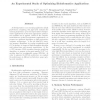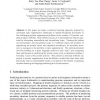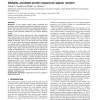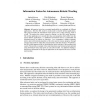282 search results - page 51 / 57 » On predicting secondary structure transition |
IPPS
2006
IEEE
14 years 1 months ago
2006
IEEE
As bioinformatics is an emerging application of high performance computing, this paper first evaluates the memory performance of several representative bioinformatics application...
ISMIS
2005
Springer
14 years 1 months ago
2005
Springer
In this paper, we adapt a statistical learning approach, inspired by automated topic segmentation techniques in speech-recognized documents to the challenging protein segmentation ...
CODES
2008
IEEE
13 years 9 months ago
2008
IEEE
The capacity of flash-memory storage systems grows at a speed similar to many other storage systems. In order to properly manage the product cost, vendors face serious challenges ...
BIOINFORMATICS
2010
13 years 7 months ago
2010
Motivation: To test whether protein folding constraints and secondary structure sequence preferences significantly reduce the space of amino acid words in proteins, we compared th...
GI
2009
Springer
13 years 5 months ago
2009
Springer
: Information fusion has a potential applicability to a multitude of different applications. Still, the JDL model is mostly used to describe defense applications. This paper descri...




